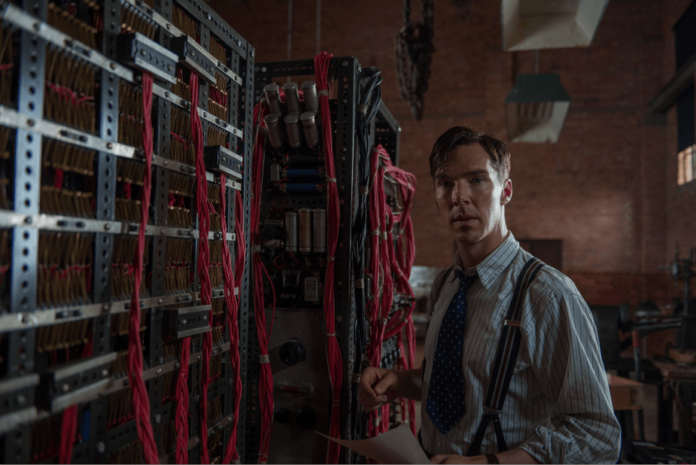
By S. Barry Cooper, University of Leeds
The Alan Turing story brings us face-to-face with many contrasts. None is more striking than that between this week’s red-carpet Gala premiere of The Imitation Game at the BFI London Film Festival, with stars Benedict Cumberbatch and Keira Knightley in attendance; and Turing’s lonely passing in Manchester on the night of June 7 1954, just a few days before his 42nd birthday. It is Turing the mathematical genius we remember today – founder of the computer age and key figure in shortening World War II by at least two years. We remember the man who brought Bayesian statistics, computing machines and cryptographic brilliance to Bletchley Park.
If we have delved a little further and read Andrew Hodges’s revealing biography Alan Turing: the Enigma, on which the film is loosely based, we will also know about Alan the 14-year-old at Sherborne School in Dorset of whom his housemaster Geoffrey O’Hanlon wrote in a 1926 school report:
Slightly less dirty & untidy in his habits: & rather more conscious of a duty to mend his ways. He has his own furrow to plough, & may not meet with general sympathy: he seems cheerful, though I’m not always certain he really is so.

Other teachers were less sympathetic, commenting on his “extreme untidiness” (Natural Science), or simply: “Rather poor” (Latin). The mistakes were characteristic, but only peppered grand overarching truths: his famous 1936 paper introducing us to the Universal Turing Machine, precursor of the modern computer, the iPhone and much else, needed a supplementary article of corrections.
By all accounts, Benedict Cumberbatch’s engagement with the man Turing, who was both supreme visionary and man cruelly betrayed by his country, is impressive. Alan was gay and following a now infamous 1952 court case, was driven to accept treatment using female hormones. It is fair to say that this comprehensively wrecked both his social and scientific life. In one interview with Cumberbatch, I am struck by his honesty and empathy with Turing’s demise. “He was at his physical and wits’ end,” Cumberbatch says:
Everything he had was going: his intellect, his stature as a human being, his health. He became a shell of what he was. And that upset me, to strip him down to that level.
Many think that Turing’s sexuality was a distraction from his remarkable work. But Turing’s interest in the human mind, for instance, did seem to reflect his own search for identity in a world that was computationally complex. His conversion of a Victorian imitation game which involved identifying hidden respondents as male or female into research on artificial intelligence clearly resonates with his need to downplay his sexuality in a less tolerant pre-1960s England.
At every turn, the sheer openness and prescience of so much of Turing’s thinking and its relationship to his own personal contradictions is inescapable. He had an extraordinarily diverse set of interests. There’s the brilliance of the early mathematics. Then his statistical work, which is as relevant to today’s “big data” challenges as it was to decoding German messages at Bletchley Park. This also feeds into his work in computational models; further, we get the work on “mechanical intelligence”. This led on to debates on the nature of intelligence and the stunningly innovative work uncovering mathematics’ underlying form in nature.
And all this groundbreaking work we can recognise as being part of a personal quest. Turing’s devotion to understanding how the world computes appears in diverse forms, and can be seen as part of his search for identity.

Courtesy of Sherborne School
Beneath all this genius was a boy, a young Alan Turing who was “dumped” (to quote a family member) on foster parents in Hastings by parents serving the Empire in India. A geekish Sherborne schoolboy, his one love (encased in shared scientific interests) was fellow pupil Chris Morcom, who died unexpectedly even as they planned their joint progression to Cambridge University. Turing’s Sherborne housemaster, again, is best placed to tell us about this boy. Here he is writing Turing’s obituary for the school magazine The Shiburnian in 1954:
His contemporaries, boys and masters, probably did not realise his originality was of a sort that any school is lucky to have once in a century, if ever. They knew him as clever, odd, unpredictable, and perhaps tiresome.
For those who knew him here the memory is of an even-tempered, lovable character with an impish sense of humour and a modesty proof against all achievements. You would not take him for a Wrangler, the youngest Fellow of King’s and the youngest FRS, or as a Marathon runner, or that behind a negligé appearance he was intensely practical. Rather you recollected him as one who buttered his porridge, brewed scientific concoctions in his study, suspended a weighted string from the staircase wall and set it swinging before Chapel to demonstrate the rotation of the Earth by its change of direction by noon, produced proofs of the postulates of Euclid, or brought bottles of imprisoned flies to study their “decadence” by inbreeding.
This was written only 23 years after Alan Turing left Sherborne for Cambridge. Ahead of him was a tragically short career, but one of incalculable impact on the modern world. We owe an immense debt of gratitude to all concerned with the making of The Imitation Game. Only now is the wider world coming to terms with Alan Turing’s remarkable legacy.
![]()
S. Barry Cooper receives funding from the John Templeton Foundation.
This article was originally published on The Conversation.
Read the original article.



















